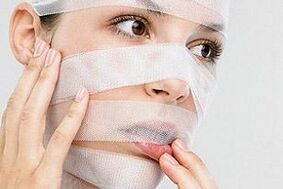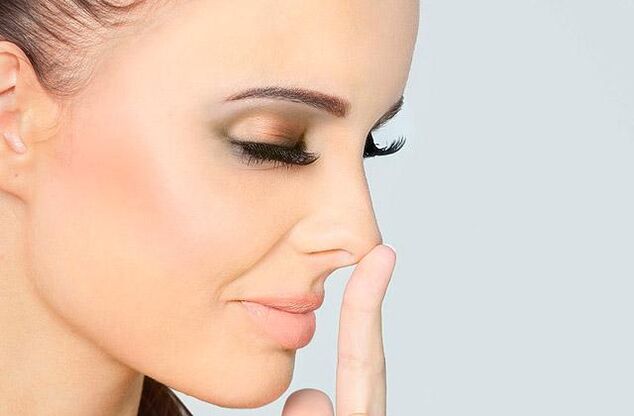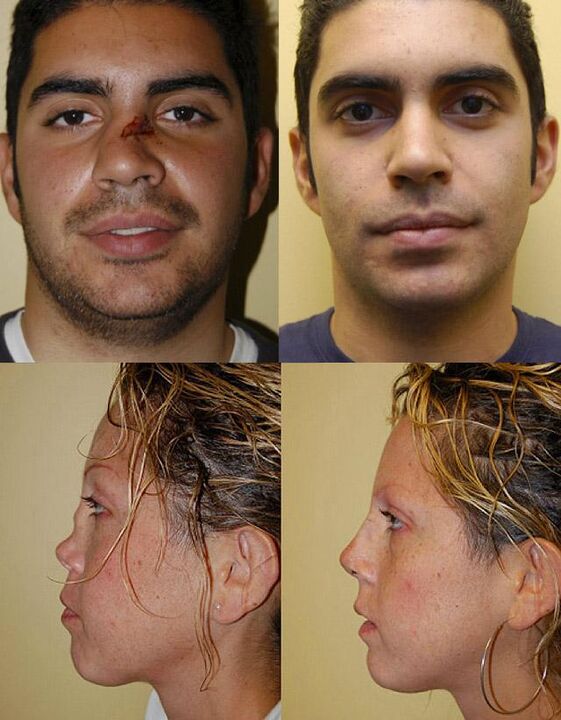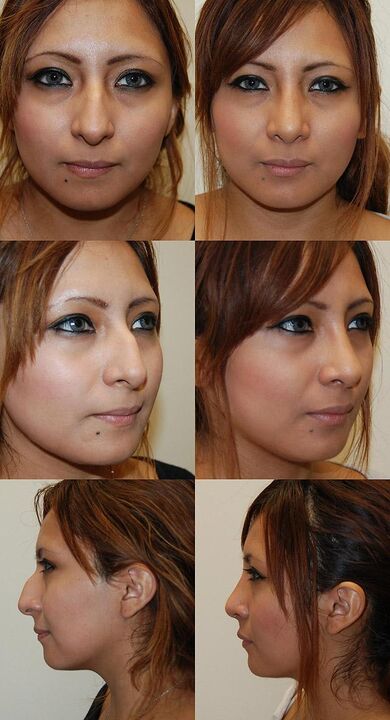
Rhinoplasty (rhinoplasty) is the correction, restoration and correction of the structure of the nose with plastic surgical techniques. It is used for medical and aesthetic reasons.
Despite its prevalence, nasal correction surgeries are still considered one of the most difficult.
Nasal repair surgeries have been performed for thousands of years. Ancient manuscripts bear witness to the successful experience of such procedures long before our time.
Medicine is far advanced compared to ancient doctors, and modern rhinoplasty is more of a cosmetic procedure than a medical necessity.
Indications for rhinoplasty
All plastic surgeries are a complex creative process that combines the issues of solving aesthetic problems with preserving or restoring specific functional features of the organ (in this case, nasal breathing).
Thus, rhinoplasty can be performed for both therapeutic and aesthetic purposes. The optimal age is 25-35 years.
Medical indications:
- congenital deformity of the nasal septum;
- turbine polyps and hypertrophy;
- traumatic injuries and post-traumatic changes in bones, cartilage, physiological (due to uneven tissue development) or compensatory curvature of the nasal septum;
- explicit violation or complete lack of nasal breathing.
Changes in the correct anatomical structure of the nose often cause functional disorders and pathological conditions - shortness of breath, atrophy or hypertrophy of the nasal mucosa, rhinosinusitis, otitis media, common respiratory illnesses, night snoring.
In addition, in children, such defects can cause chronic oxygen starvation in the brain, leading not only to their physical but also to mental retardation, and affecting their mental development and behavioral reactions. Therefore, rhinoplasty can be performed on children under 18 years of age.
The cause of rhinoplasty is more than 60% of the patient’s desire to improve the shape of the nose so that its appearance achieves complete harmony. Plastic surgeon services are becoming increasingly popular. The aesthetic indications for rhinoplasty can be divided into two major groups:
- objective - they are disproportionate and unattractive in size or nose-shaped;
- subjective or psychological: there are no specific criteria for evaluating beauty, every person has his or her own stereotype, so for personal reasons he or she may not like his or her nose.
These causes often affect people’s professional and personal relationships, create complexes of dissatisfaction, and their own inferiority, especially in the female environment, leads to social unfoundedness.
Rhinoplasty for aesthetic purposes is indicated in cases where:
- the disproportionate size of the nose in relation to the whole face - too large or, conversely, too small;
- congenital or acquired deformities;
- curvature of the nasal septum;
- dilated nostrils, hump;
- misalignment of the asymmetrical tip of the fork, recessed or raised, and the back height of the nose;
- saddle shape;
- the aesthetically unsatisfactory result of the previous operation.
In many cases, the medical and aesthetic indications are the same and the consequences of anatomical defects are the same.

Types of rhinoplasty
According to the desired goal and the technique of the surgical procedure, rhinoplasty is divided into the following:
- Reconstructive to restore anatomical abnormalities resulting from improper intrauterine development, traumatic injury, or disease.
- Aesthetic - correcting existing deficiencies.
According to the same criteria, there are several types of rhinoplasty:
- Reduction or enlargement of the nose.
- Backrest adjustment - adjust the saddle recess or remove the hump.
- Correcting the aesthetic flaws of the top.
- Septic correction (septoplasty).
- Post-traumatic reconstruction of the structure.
Each type of operation is divided into:
- primary;
- secondary;
- repeated.
Access techniques
The following techniques are used during rhinoplasty, depending on the access options:
- Closed rhinoplasty,in which incisions may occur in the nasal cavity. Closed access is divided into marginal (along the inner surfaces of the wings of the nose), transeptal, inter-, and transchondral. After the incision, the soft tissues are separated (separated) from the cartilage and bones that make up the frame, allowing the necessary manipulations to be performed freely. Closed rhinoplasty is less traumatic than open rhinoplasty and eliminates arterial damage and tissue malnutrition, and postoperative scars are completely invisible because they are located in the nasal cavity. It is most commonly used, especially for aesthetic rhinoplasty.
- Open rhinoplasty- the incision passes through the columella (the part of the skin between the folds of the nostrils) and the wings of the nose when they meet their lips. The technique is used in cases that do not allow for a different (closed) implementation of the task. It allows soft tissues and cartilage to be lifted upwards, proper access to the inside of the nose, and manipulations performed under constant visual inspection. Open rhinoplasty is required to correct particularly severe changes as well as technically complex and significant operations - pronounced deformation of the nose, especially in the case of lateral displacement; a combination of nasal deformity with disorders such as "cleft lip" or cleft palate; reconstruction using grafts. The disadvantages of open rhinoplasty are the development of a noticeable postoperative scar as well as forced damage to the arteries of the columella, resulting in significant and prolonged postoperative tissue edema.
Rhinoplasty of any type is performed under one type of general anesthesia and usually lasts 1-2 hours. Sometimes it can last up to three hours or more.
How do we do rhinoplasty?
The operation is performed in the following order:
- nasal septum correction is performed;
- if necessary, the nasal peel is reduced;
- the nasal hump is corrected if a uniform profile is required;
- the bones are dissected and shifted to narrow the pyramid of the nose;
- straightens the nose;
- mountain repair.
Revision rhinoplasty
Nasal plastic surgery is considered if surgery has already been performed in this area. The final formation of the nose occurs within six months to 1 year after plastic surgery. This period is optimal for operation again. It is carried out if:
- the impossibility of achieving the goal in one stage;
- unsatisfactory results of the primary operation;
- the need to correct problems remaining after primary rhinoplasty.
According to world statistics, 25-30% of patients who have undergone primary rhinoplasty require a second corrective surgery. This is considered normal. It usually lasts up to half an hour and is performed under local anesthesia. Corrective revision surgery allows for the correction of scarring imperfections and produces an aesthetic result for the shape of the nose that meets the needs of the surgeon and the patient.
Rhinoplasty is much more difficult to repeat in the case of a poorly performed primary or unfavorable course of the rehabilitation period, which often depends on the individual characteristics of the body and the complications. Such operations require deeper investigation and more thorough preparation. One option is to represent a full-fledged plastic, but they are usually much more complicated and time consuming. Minor defects during repeated plastic surgeries can lead to permanent disruption of the shape, not only at the apex, for example, but also to pronounced deformation of the entire nose.
Complications and preparation for surgery
Rhinoplasty is considered one of the most difficult plastic surgeries, the outcome of which depends largely on the skill and experience of the surgeon. Complications occur in 4-15% of cases. They may be during surgery (bleeding, skin cracks, rupture of the mucous-cartilage wing, violation of the integrity of the bone pyramid, fracture of the bone site, etc. ) and postoperatively.
Possible complications after rhinoplasty:
- functional - atrophic rhinitis, difficulty breathing, loss of odor, temporary or permanent decrease or complete loss of skin sensitivity of the nose and upper lip;
- aesthetic - previous deficiencies do not change or worsen;
- psychological - patient dissatisfaction with the results of plastic surgery;
- infectious - prolonged swelling and inflammation, dizziness;
- nasal skin pigmentation, vascular development, mucosal adhesions, and rough scars;
- recurrent epistaxis and soft tissue or cartilage necrosis.
The preparation consists of:
- Consultation with a plastic surgeon, during which the technical possibilities for fulfilling the patient's wishes are determined.
- Conducting general examinations - clinical and biochemical blood tests, coagulation test (coagulogram), general urine analysis, hepatitis, HIV, syphilis (RW), ECG tests.
- Perform special examinations (if necessary) - images of paranasal sinuses, endoscopic examination of the nasal cavity to identify concomitant disorders and abnormalities.
- A computer simulation that allows the patient to compare the initial state of the nose with the results of future rhinoplasty.
- Consultations with a therapist and specialists (in the presence of chronic diseases).
- Examination by an anesthesiologist after each examination.
- Two weeks before surgery, refusal of drugs that affect blood clotting processes - acetylsalicylic acid and its analogues, anticoagulants.
- Stop taking sedatives and hypnotics on the day of the procedure.
Contraindications and rehabilitation
Absolute contraindications for rhinoplasty:
- the presence of any chronic systemic disease in severe form (endocrine, cardiovascular, lung);
- acute infectious diseases;
- coagulation disorders;
- the day of menstruation.
Basic recovery after rhinoplasty takes up to 3 weeks. However, the deadline for complete completion of the rehabilitation period, when the results are assessed, is determined by the doctor and is 6-12 months. During this time, certain restrictions must be observed.
1-1, 5 weeks after the procedure, the plaster bandage and sutures are removed. During the first two weeks, do not wash with hot water or take a hot bath, as bleeding, bruising and swelling may occur all over the face and neck. It is necessary to lie only on your back in an elevated position, which makes it easier to breathe and reduces swelling. It is advisable to wear a face shield in dusty places. Bending and lifting the weight should be avoided.
You must stop using your glasses and wear a tight or heavy hat within three months. You cannot visit the pool and sunbathe for 3 months. In hot weather and sunshine, an umbrella or wide-brimmed hat is recommended.
When designing rhinoplasty options, an experienced surgeon follows the principles of three types of limitations: it is determined by the surgeon himself; restrictions imposed by the patient; limitations related to the patient’s condition and anatomical features of the nose.



Price
The cost of the operation depends on the complexity of the correction.
Recommendations
A woman reviewing
"Because of the shape of my nose, I've always had complexes. It was too long, it was a hump, and the tip of my nose looked bifurcated. Last year I decided I was going to do a rhinoplasty. If I had done it earlier, my life would be better now, probably better. "Even the septum, which I didn't know was wrong, has been restored. My nose is perfect, as am I. "
Review review
"After my nose broke several times, my nasal septum moved. I couldn't breathe normally, I snored heavily at night. The diagnosis showed temporary shortness of breath in my dream. My nose looked ugly, it shifted to one side. I have rhinoplasty to straighten my nose. I did. I'm happy with the result. Now my nose is as normal as before the fractures. It always breathes and I don't snore anymore. "
Rhinoplasty is not always a whim, but is most often justified by objective necessity. It is important to choose a competent surgeon and make sure you have no contraindications to the procedure.






















